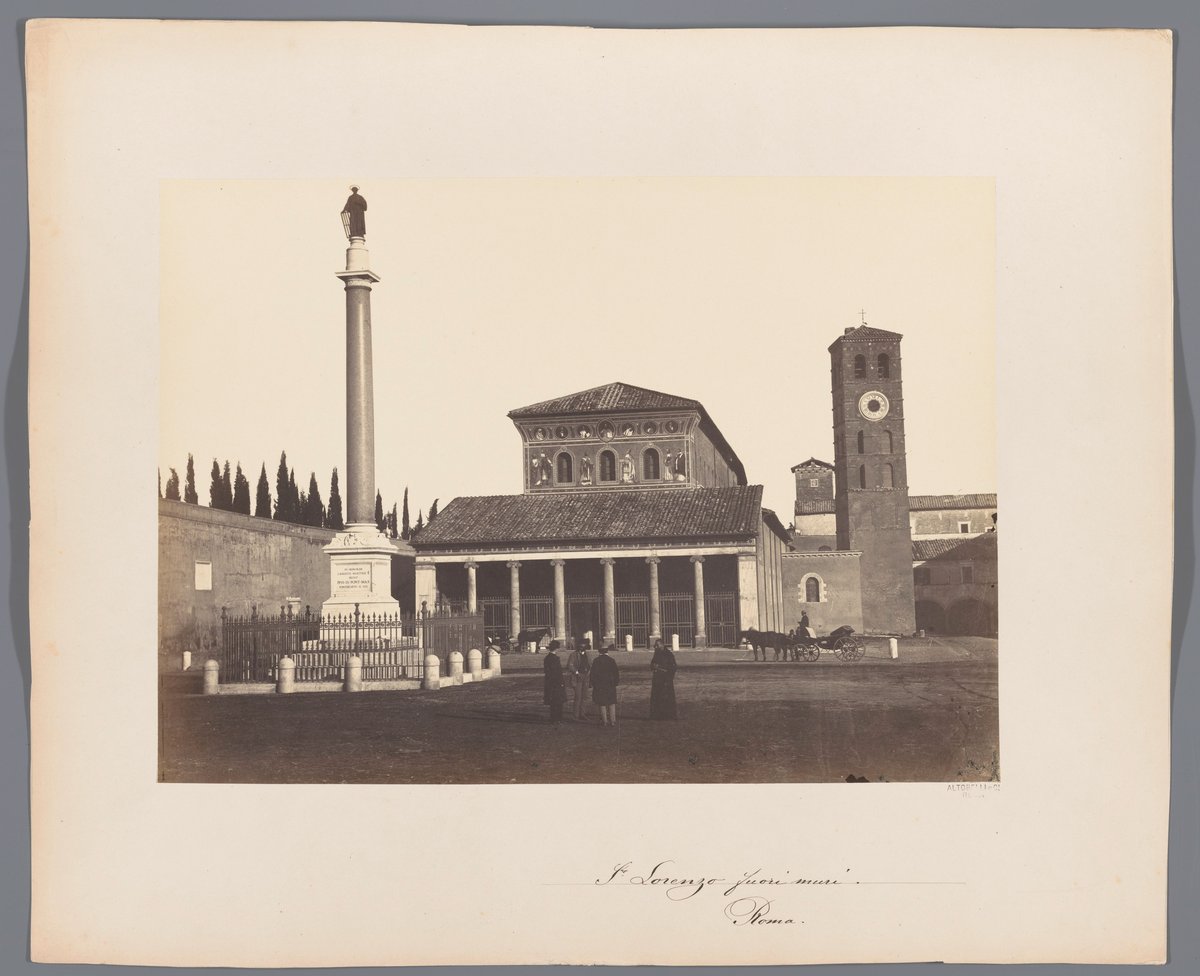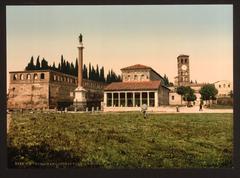
Basilica of Saint Lawrence Outside the Walls: Visiting Hours, Tickets, and Historical Significance
Date: 14/06/2025
Introduction
The Basilica of Saint Lawrence Outside the Walls (San Lorenzo fuori le Mura) is one of Rome’s most important historical and spiritual landmarks. Founded in the 4th century by Emperor Constantine on the burial site of Saint Lawrence—one of early Christianity’s most revered martyrs—the basilica has evolved through centuries of architectural change, religious devotion, and cultural significance. It is one of the city’s five papal basilicas, a vital stop on the Seven Pilgrim Churches route, and home to remarkable cosmatesque floors, medieval frescoes, revered relics, and papal tombs. This guide provides a comprehensive overview for visitors, including historical context, architectural highlights, practical visitor information, accessibility, travel tips, and recommended resources for further exploration.
For the most up-to-date information, visitors are encouraged to consult the official basilica website and trusted guides such as Port Mobility, Liturgical Arts Journal, Lonely Planet, and The Complete Pilgrim.
Table of Contents
- Historical Overview
- Architectural Evolution
- Religious and Cultural Significance
- Visitor Information
- Highlights and Notable Features
- Travel Tips and Nearby Attractions
- Frequently Asked Questions (FAQ)
- Conclusion and Further Resources
Historical Overview
Origins and Early Development
The basilica’s history is rooted in the martyrdom of Saint Lawrence, a deacon executed during the persecutions of Emperor Valerian in 258 CE. His burial site became a revered place of Christian pilgrimage. The earliest basilica, commissioned by Pope Sylvester I under Emperor Constantine (early 4th century), was designed to honor the saint and accommodate the growing number of pilgrims. According to the Liber Pontificalis, it was built “on the Via Tiburtina in the Verano field above the sandpit of the crypt” (official basilica website). The original structure had a circiform (oval) plan, a common feature among early Roman basilicas built over martyrs’ tombs.
Major Transformations
- 6th Century – Pelagian Basilica: Pope Pelagius II commissioned a new church above the saint’s burial site, integrating and expanding the earlier Constantinian structure. The crypt became a key pilgrimage focus (official basilica website).
- 13th Century – Honorian Expansion: Pope Honorius III transformed the basilica, extending it westward, raising the floor, and unifying the earlier eastern (Pelagian) and new western basilicas. The result is the unique, slightly misaligned layout seen today.
- Modern Restorations: The basilica survived fires, earthquakes, and the devastation of World War II bombings. Restoration in the mid-20th century recovered much of its medieval character while repairing structural damage (Liturgical Arts Journal).
Architectural Evolution
Exterior Features
- Facade and Portico: The brick facade, rebuilt after WWII, preserves an austere, early Christian style. The portico, with medieval frescoes, narrates the martyrdom of Saint Lawrence and scenes from the lives of Saints Lawrence and Stephen (Lonely Planet).
- Bell Tower (Campanile): The 12th-century bell tower, part of the medieval defensive complex, remains a prominent feature.
- Cemetery and Catacombs: Adjacent to the Verano Cemetery, the basilica is connected to the Catacombs of Ciriaca, historically the burial site of Saint Lawrence and decorated with early Christian art.
Interior Highlights
- Nave and Sanctuary: The nave, with its cosmatesque (geometric marble mosaic) floor and reused Roman columns, opens into a raised sanctuary preserving the earlier church’s apse and triumphal arch.
- Cosmatesque Decoration: Intricate marble mosaics and furnishings (ciborium, ambos) exemplify medieval Roman craftsmanship.
- Crypt and Relics: Beneath the high altar rests the tomb of Saint Lawrence, marked by a marble slab and believed to contain relics of both Saint Lawrence and Saint Stephen. The crypt also houses the tomb of Pope Pius IX.
Religious and Cultural Significance
San Lorenzo fuori le Mura is one of Rome’s five papal basilicas and a traditional stop on the Seven Pilgrim Churches route—essential for pilgrims, especially during Jubilee Years. The basilica’s dual dedication to Saint Lawrence and Saint Stephen highlights the early Church’s veneration of deacon-martyrs. The tombs of several popes, including Pius IX, and the relics of other saints underscore its status as a center for both spiritual devotion and ecclesiastical history.
The basilica remains an active parish, hosting daily Mass, special liturgies on Saint Lawrence’s feast (August 10), and community events that draw both locals and international visitors (Port Mobility).
Visitor Information
Location and Access
- Address: Piazzale del Verano, Via Tiburtina, San Lorenzo district, Rome.
- Public Transport: Accessible via tram (lines 3, 19 at “San Lorenzo”), bus (lines 218, 360), and a 20-minute walk or short ride from Termini station (Lonely Planet).
Opening Hours
- General Hours: Usually open daily from 7:30 am–12:00 pm and 4:00 pm–7:00 pm. Hours may vary for religious services, funerals, or holidays. Always check the official website before your visit.
Admission and Tickets
- Entry: Free of charge. No advance booking or ticket is required. Donations are welcome to support maintenance and restoration.
Guided Tours and Audio Guides
- Tours: Guided tours are available via local operators and occasionally at the basilica—advance booking is recommended.
- Audio Guides: Downloadable apps such as Audiala offer in-depth commentary and virtual tours.
Accessibility
- Physical Access: The main nave is wheelchair accessible via ramps. The crypt and cloister have limited accessibility due to stairs and uneven terrain. If you have specific needs, contact the basilica in advance for information.
Dress Code and Etiquette
- Dress modestly (shoulders and knees covered).
- Remain quiet, especially during religious services.
- Photography is allowed (no flash or tripods).
Highlights and Notable Features
- Cosmatesque Floor: Exceptional 13th-century mosaic flooring—one of Rome’s finest examples.
- Frescoes and Art: Medieval frescoes in the portico and nave, including scenes from the lives of Saints Lawrence and Stephen.
- Tombs and Relics: The crypt beneath the altar is the resting place of Saint Lawrence, Saint Stephen (according to tradition), Pope Pius IX, and other notable figures.
- Cloister: The tranquil cloister features inscriptions and sarcophagi, leading toward the Catacombs of Ciriaca.
- Pilgrimage Significance: One of Rome’s Seven Pilgrim Churches and a vital stop for religious travelers.
Travel Tips and Nearby Attractions
- Best Time to Visit: Early morning or late afternoon for fewer crowds and optimal lighting.
- Recommended Duration: Allow 1–1.5 hours for a thorough visit.
- Nearby Sites: Verano Cemetery (monumental tombs), Basilica of Santa Croce in Gerusalemme, ancient Aurelian Walls, Villa Torlonia, and the lively San Lorenzo district with authentic Roman trattorias.
- Facilities: Basic restrooms available; additional amenities in nearby cafes.
Frequently Asked Questions (FAQ)
Q: What are the Basilica of Saint Lawrence Outside the Walls visiting hours?
A: Generally 7:30 am–12:00 pm and 4:00 pm–7:00 pm daily, but check the official website for changes.
Q: Is there an admission fee?
A: No, entry is free.
Q: Are guided tours available?
A: Yes, via local tour operators or by special arrangement; advance booking is recommended.
Q: Is the basilica wheelchair accessible?
A: The main nave is accessible by ramp; the crypt and cloister have limited access.
Q: Can visitors attend Mass?
A: Yes, all are welcome to attend services—please respect the sacred atmosphere.
Q: What is the dress code?
A: Modest attire—shoulders and knees covered.
Q: Is photography allowed?
A: Photography is permitted, but avoid flash and tripods, especially during services.
Conclusion and Further Resources
The Basilica of Saint Lawrence Outside the Walls is a testament to Rome’s early Christian heritage, artistic mastery, and enduring spiritual significance. Its layered history, architectural splendor, and tranquil setting offer a meaningful experience for pilgrims, history enthusiasts, and casual visitors alike. To enrich your visit, consider a guided tour, use the Audiala audio guide, and explore the resources below for further reading.
For current schedules, events, or to plan your visit, see the official basilica website.
References and Further Reading
- Basilica of Saint Lawrence Outside the Walls – Liturgical Arts Journal
- Basilica of Saint Lawrence Outside the Walls – Official Website
- Basilica of Saint Lawrence Outside the Walls – Port Mobility Guide
- Basilica di San Lorenzo fuori le Mura – Lonely Planet
- Basilica of Saint Lawrence Outside the Walls – The Complete Pilgrim


















































































































































































































































